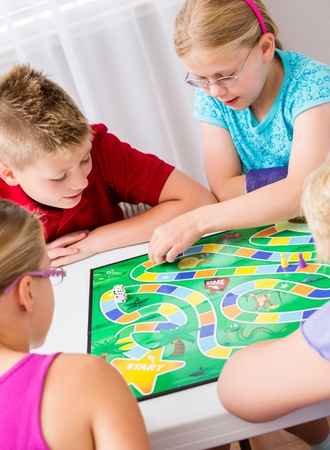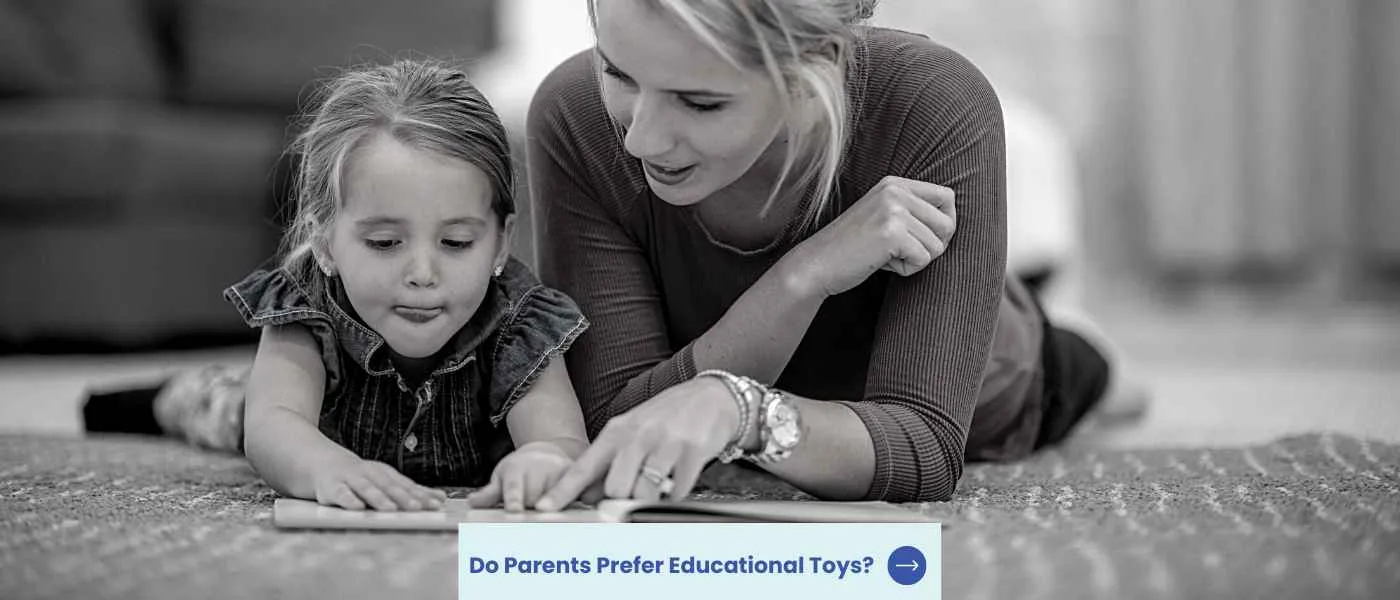As parents, we all want to give our children the best start in life. From the moment they are born, we strive to provide them with the love, care, and attention they need to grow and thrive. And one of the most important ways we can do this is through play.
Play is a vital part of a child’s development, helping them to learn about the world around them. And when it comes to play, there is a lot of debate about whether educational toys are really worth the investment. So, do parents really prefer educational toys for their children?
In this blog post, we’ll discuss the importance of play in a child’s development and take a closer look at the benefits of educational toys. We’ll also examine some of the common myths and misconceptions about these toys and provide insights into why parents should consider them for their child’s development.
Key Takeaways on How Parents Select Toys
- Play is an essential aspect of a child’s development. It promotes cognitive, social, and emotional development and provides children with the necessary skills to succeed in life.
- Educational toys are an effective way to support children’s learning and development. By providing children with fun and engaging learning experiences, these toys can help children develop a range of skills and abilities that will serve them well throughout their lives.
- Modern parents prefer educational toys for their children because they provide children with an opportunity to learn while having fun, help them develop important life skills, are designed with safety in mind, and allow parents to take an active role in their child’s education.
Why Is Play Important in Early Childhood?
Play has an integral role in a child’s development. It provides children a sense of discovery that enables them to learn, and develop skills that are essential for their cognitive, social, and emotional development.
Cognitive Development
Play allows children to engage in various activities that promote cognitive development. For example, through play, children can learn how to solve problems, think critically, and use their imagination. Pretend play, for instance, allows children to create scenarios and situations, imagine different outcomes, and learn how to work with others. Furthermore, play allows children to develop their memory, attention, and language skills, which are essential for their cognitive development.
Social Development
Play provides children with opportunities to interact and engage with other children, which is critical for their social development. Through play, children learn how to communicate, share, and cooperate with others. For example, playing games with other children can teach them how to take turns, follow rules, and manage their emotions. In addition, play allows children to develop empathy and understanding of others, which is vital for building healthy relationships in the future.

Emotional Development
Play helps children to develop their emotional skills, which are essential for their well-being. It allows children to express their feelings, and it enables them to develop their emotional intelligence. Through play, children can learn how to manage their emotions, build their confidence, and develop resilience. Play also provides children with a safe and fun environment to discover and experiment with their feelings, which is crucial for their emotional development.
How Do Educational Toys Help in Children’s Development?
Educational toys are designed to enhance learning, encourage creativity and imagination. These toys provide a fun and engaging way for children to learn and grow, while also promoting their cognitive, social, and emotional development.
- Toys that enhance learning can help children develop a range of skills, including language, math, science, and social studies. Building blocks can help kids learn about shapes, sizes, and spatial relationships, while puzzles can help them improve their memory and concentration.
- Toys that encourage creativity and imagination can help children develop their artistic and imaginative abilities. Art supplies such as paint, crayons, and markers can help children express themselves creatively, while dress-up costumes and props can help them explore different roles and scenarios.
- Toys that develop analytical thinking can help kids think critically and solve problems effectively. Board games such as chess and checkers can help children develop strategic thinking skills, while science kits and experiments can help them learn about cause and effect and scientific principles.
Why Do Many Parents Buy Educational Toys?
Modern parents are increasingly turning to educational toys as a way to enhance their child’s early learning and development. There are several reasons why parents prefer these toys, and in this article, we will explore some of the most important ones.
First and foremost, educational toys provide children with an opportunity to learn while having fun. Unlike traditional toys, which are designed solely for entertainment purposes, educational toys are specifically created to help children develop their cognitive, motor, and social skills. These toys can be used to teach children about different subjects, such as math, science, and language, in an engaging and interactive way.
Another reason why parents prefer educational toys is that they can help children build important life abilities. For instance, toys that require critical thinking, and creativity can help children develop these abilities at an early age. Similarly, toys that encourage children to work together and communicate effectively can help them build social skills that will benefit them throughout their lives.
Parents also appreciate the fact that educational toys are often designed with safety in mind. Unlike some traditional toys, which may be made from unsafe materials or have small parts that can be a choking hazard, educational toys are typically made from non-toxic materials and are designed to be age-appropriate.
Finally, parents recognize the importance of their role in their child’s early learning and development. By providing their children with educational toys, parents can take an active role in their child’s education and help them develop the skills they need to succeed in school and beyond.
For example, a parent may choose to give their child a puzzle to work on. As the child works on the puzzle, the parent can ask them questions about the shapes and colors they are seeing, helping to reinforce their understanding of these concepts. The parent can also encourage the child to think creatively, suggesting different ways to complete the puzzle and praising their efforts as they go.
What Factors Influence Parent’s Toy Selection?
When it comes to choosing toys for their children, parents are influenced by various factors. One of the most significant factors is the child’s age and developmental stage. Parents understand that different toys cater to different age groups, and they want to ensure that the toys they select are appropriate for their child’s current stage of development.
A parent of a newborn baby would look for toys that promote sensory development, such as soft and textured toys that encourage exploration through touch. Meanwhile, parents of curious toddlers would opt for toys that help develop social and motor skills, such as puzzles and wooden blocks during play time.
Another crucial factor that influences parents’ toy choices is their values and beliefs. Some parents prioritize educational toys that promote learning and development, while others focus on toys that promote physical activity and outdoor play. Other parents are interested in toys that reflect their cultural or religious beliefs.
Lastly, parents take into consideration their child’s interests when selecting toys. They want to choose toys that their little boys and girls will enjoy playing with and will keep them engaged. Parents may observe their child’s play habits and preferences to determine what type of toys will best suit their interests.

What Should Parents Look For in a Toy?
Here are some general considerations that parents may want to consider before buying toys in the holiday season or during the school year:
- Age-appropriateness. Toys should be chosen with a child’s age and developmental level in mind. Young children require toys that are safe and easy to manipulate, such as toys with large buttons or soft textures, while older kids may benefit from toys that offer more complex challenges, such as building sets or puzzles. It is important to choose toys that are appropriate for a child’s age to ensure that they are both safe and engaging.
- Parents should take care to ensure that the toys they give their kids are safe and free from hazards such as small parts, sharp edges, or toxic materials. It is important to read product labels and instructions carefully to ensure that the toy meets safety standards. Additionally, parents should regularly inspect toys for signs of wear and tear, and dispose of any damaged or broken toys immediately.
- Toys can be a valuable tool for promoting learning and development. Parents may want to look for toys that offer educational value, such as toys that improve problem-solving skills, promote creativity, or enhance language and literacy skills. By choosing educational toys, parents can help their children develop important skills and knowledge that will benefit them throughout their lives.
- Parents should consider the durability of the toy before making a purchase. Children’s toys are often subjected to rough play and repeated use, so it is important to choose toys that can withstand this type of wear and tear. Durable toys will last longer and provide more value to the child over time.
- Toys should be engaging and fun to play with, encouraging imaginative play and exploration. Children learn best through play, so it is important to choose toys that are both enjoyable and stimulating. Look for toys that inspire creativity and allow kids to explore their interests and imaginations.
- When choosing toys, parents should consider the price and whether the toy is worth the investment in terms of its quality and value to the child. While more expensive toys may offer more features or durability, it is important to find a balance between cost and value. Parents should also consider the long-term benefits of the toy, such as its educational value and potential for long-term play.
- Research toy manufacturers before buying any toys from them. Look for any recalls and what other parents have to say about their experience.
What Are the Limitations of an Educational Toy?
Most parents purchase toys that they think will help their kids learn. Educational toys are designed to facilitate the learning process by providing kids with an engaging and interactive play experience. However, it’s important to recognize that these toys have some limitations.
- Educational toys may only focus on specific skills and may not cover a broad range of subjects. For example, a toy that teaches math may not teach language skills, and vice versa. This can lead to a narrow focus on a particular skill or subject, potentially limiting a child’s overall development.
- These toys may not be suitable for all children ages or skill levels. A toy that is too advanced for a child’s skill level may lead to frustration and discouragement. On the other hand, a toy that is too basic may not provide enough of a challenge and may not promote growth and development.
- These toys are not a substitute for real-life experiences and interactions. Kids need to interact with the world around them and learn from real-world situations to fully develop their skills and abilities.
- An educational toy can be expensive, and not all families can afford them. This may lead to disparities in learning opportunities among kids from different socioeconomic backgrounds.
What Are Good Ideas for Alternatives to Educational Toys?
In recent years, educational toys have gained popularity as a way to enhance children’s learning and development. However, there are alternatives to these toys that can be just as beneficial. Open-ended toys, everyday items, and nature and outdoor play are all great ways to stimulate children’s imaginations and promote learning.
Open-ended toys, such as blocks, dolls, and art supplies, allow kids to explore and create in their own way. These toys do not have a specific purpose or outcome, which encourages children to use their creativity and problem-solving skills. By playing with open-ended toys, younger children can develop important skills social and emotional intelligence.
Everyday items, such as pots and pans, cardboard boxes, and blankets, can also be great toys for children. These items can be used in a variety of ways, from building forts to pretending to cook a meal. By using everyday items as toys, kids learn to think outside the box and develop their creativity and imagination.
Nature and outdoor play is another alternative to educational toys. Spending time in nature and playing outside allows children to explore and learn about the world around them. They can learn about different plants and animals, develop physical skills, and learn to appreciate the natural world.

Why Are Toys Better Than Technology?
Toys and technology both have their own benefits and drawbacks, and it’s difficult to say one is universally better than the other.
Toys can provide opportunities for imaginative play, physical activity, and social interaction. Playing with toys can also help children develop crucial skills such as problem-solving, creativity, and communication. Furthermore, some toys like puzzles or board games can aid in cognitive development and sharpen mental abilities.
On the other hand, technology can provide access to vast amounts of information, educational resources, and entertainment. It can also allow for remote learning and communication with people who are far away, and provide tools for creative expression. However, excessive use of technology can lead to sedentary behavior, social isolation, and addiction. It limits social interactions that children lost out on.
Ultimately, the best choice depends on the child’s circumstances, interests, and goals. It’s important to find a balance between using technology and engaging in other activities, such as playing with toys, for a well-rounded and healthy lifestyle.




